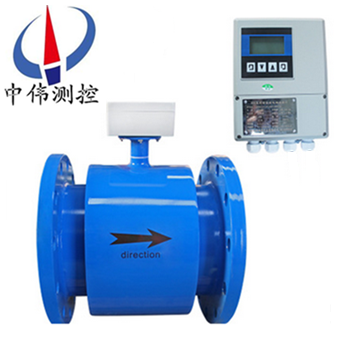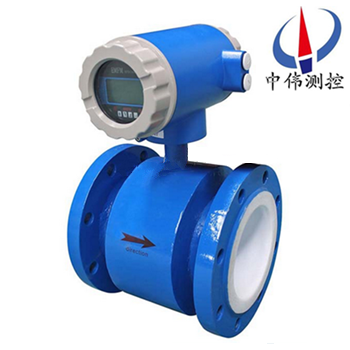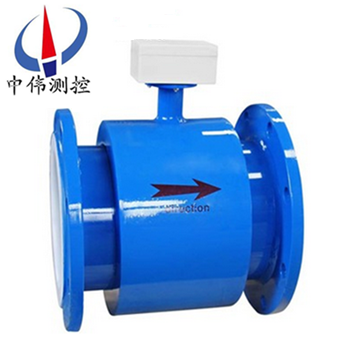Electromagnetic flowmeter
I. product overview
Zw-lde series electromagnetic flowmeter is an induction-type meter which CAN measure the volume flow of conductive medium in the tube according to Faraday's law of electromagnetic induction. It adopts the embedded technology of single chip microcomputer to realize digital excitation. Meanwhile, CAN field bus is adopted on the electromagnetic flowmeter to reach the advanced level in China. It can output 4 ~ 20mA current signal for recording, adjustment and control while meeting the needs of field display. In addition to measuring the flow rate of general conductive liquid, it can also measure the volume flow rate of liquid-solid two-phase flow, liquid flow with high viscosity and liquid of salt, strong acid and strong alkali.
All-in-one electromagnetic field is excited by three-valued rectangular wave or double-frequency rectangular wave with constant current and low frequency, which not only has the advantages of rectangular wave magnetic field, but also overcomes the disadvantages of sine wave magnetic field. It can also eliminate errors caused by power supply voltage fluctuation, power supply frequency change and excitation coil impedance change. It has excellent zero point stability and is not affected by the fluid noise. Thus has the high stability, the high reliability characteristic. The electromagnetic flowmeter is composed of a sensor and a transducer mounted on a measuring pipe. The transducer can be combined with the sensor and is called a one-body flowmeter.
Split - type electromagnetic design, convenient maintenance, increase the service life of electromagnetic flowmeter. Wall-mounted flow converter, effective protection sensor conversion circuit, is conducive to anti-corrosion, moisture-proof, waterproof. Simple wiring and easy installation. The split electromagnetism is composed of a sensor and a transducer mounted on a measuring pipe. The transducer is mounted within 30 meters or 100 meters from the sensor, and the two are connected by a shielded cable to measure the volume flow of the conductive liquid. The main components of the sensor are: measuring tube, electrode, excitation coil, iron core and magnetic yoke. It is mainly used to measure the volume flow of conductive liquid and slurry in closed pipe.
Ii. Working principle
ZW - LDE series electromagnetic flowmeter based on Faraday electromagnetic induction principle, with the sounding pipe axis and the magnetic field lines in the vertical tube wall installed on a pair of detecting electrodes, when conducting liquid along the measuring tube axis movement, conductive liquid cutting lines of magnetic force induced electric potential, the induction electric potential by two detection electrodes detection, numerical size and flow into a direct ratio, its value is: E = KBVD type:
E- induction potential;
K- coefficient related to magnetic field distribution and axial length;
B- magnetic induction intensity;
V- average velocity of conductive liquid;
D- electrode spacing; (measuring pipe diameter)
The sensor takes the induced potential E as the flow signal and transmits it to the converter. After amplification, transformation and filtering, the sensor USES a series of digital processing to display the instantaneous flow and cumulative flow with a backlit point-matrix liquid crystal display. Converter has 4 ~ 20mA output, alarm output and frequency output, and rs-485 communication interface, and support HART and MODBUS protocol.
Iii. Application:
Zw-lde series electromagnetic flowmeters are mainly used to measure the volume flow of conductive liquid and slurry in closed pipes. Such as water, sewage, mud, pulp, all kinds of acid, alkali, salt solution, food slurry, etc., widely used in petroleum, chemical, metallurgy, textile, food, pharmaceutical, paper and other industries as well as environmental protection, municipal management, water conservancy construction and other fields.
Iv. Structure:
1. Sensor:
The sensor is mainly composed of a measuring conduit, a measuring electrode, an exciting coil, an iron core, a magnetic yoke and a housing.
A. Measuring catheter: it is composed of stainless steel catheter, lining and connecting flange, and it is the carrier for field working condition measurement of the measured liquid.
B. Measuring electrode: a pair of electrodes mounted on the inner wall of the measuring catheter perpendicular to the axial flow direction to generate signals from the measuring liquid.
C. Field coils: the upper and lower field coils that generate the magnetic field in the measuring tube.
D. Iron core and magnetic yoke: conduct the magnetic field generated by the excitation coil into the liquid and form a magnetic circuit.
E. Housing: outer packing of instrument.
2. Converter:
It is an intelligent secondary meter, which can display the flow and accumulative amount after amplifying the flow signal and processing the single-chip computer calculation, and can output pulse, analog current and other signals for the measurement or control of fluid flow.
3. Product assembly:
It is divided into two forms: one body type and two body types.
A. Type I: integrated installation of sensors and converters.
B. Fracturing: the sensor and converter are separated and installed, and the flow metering system is formed by connecting cables.
C. The lining and electrode materials of the sensor can be selected in a variety of ways to meet the requirements of different media measurement.
V. main features:
1, the instrument structure is simple, reliable, no moving parts, long working life;
2. No intercepting or blocking parts, no pressure loss or fluid blockage;
3, no mechanical inertia, fast response, good stability, can be used in automatic detection, regulation and program control system;
4. The measurement accuracy is not affected by the type of medium under test and its physical parameters such as temperature, viscosity, density and pressure;
5. Different combinations of ptfe or rubber liner and Hc, Hb, 316L, Ti and other electrode materials can meet the needs of different media;
6. Equipped with pipeline type, plug-in type and other flow meter models;
7. EEPROM memory is used to protect safe and reliable storage of measurement and operation data;
8, with two types of integration and separation;
9. High definition LCD backlight display.
Vi. Technical parameters
1. Instrument accuracy: pipe type 0.5 and 1.0; Plug-in 2.5.
2. Measuring medium: various liquids and liquid-solid two-phase fluids with conductivity greater than 5 S/cm.
3. Flow rate range: 0.2-8m /s.
4. Working pressure: 1.6MPa.
5, environmental temperature: - 40 ℃ ~ + 50 ℃.
6, medium temperature: ptfe lining 180 ℃ or less; Rubber lining material 65 ℃ or less.
7, explosion-proof marks: Exmibd Ⅱ BT4.
8. Explosion proof certificate no. : GYB01349.
9. External magnetic interference: 400A/m.
10. Shell protection: integrated type: IP65;
Parting type: sensor IP68 (5 m underwater, limited to rubber lining); Converter IP65.
11, the output signal: 4 ~ 20 ma DC, load resistance Ω 0 ~ 750.
12. Communication output: RS485 or CAN bus.
13. Electrical connection: M20 1.5 internal thread, phi 10 cable hole.
14. Power supply voltage: 90 ~ 220V.AC, 24 10% v.c.
15. Power consumption: 10VA.
Vii. Classification by excitation mode:
To generate a uniform and constant magnetic field, it is necessary to choose an appropriate excitation mode. If divided by excitation current mode, there are dc excitation, ac (power frequency or other frequency) excitation, low-frequency rectangular wave excitation and dual-frequency rectangular wave excitation.
1. Dc excitation
Dc excitation USES direct current or magnet to produce a constant uniform magnetic field. This dc excitation transmitter is very little affected by the interference of ac electromagnetic field, so it can ignore the influence of the self-induction phenomenon in the liquid. But using dc magnetic field is easy to make by measuring the electrolyte fluid of the pipe is polarized, the electrolyte by electrolysis in the electric field, produce positive and negative ions, in under the action of electric field force, ran to the anode, anion cation ran to the cathode, which will result in positive and negative electrodes were surrounded by ions of opposite polarity, seriously affect the normal work of the instrument. Therefore, dc excitation is generally only used to measure the flow of non-electrolyte liquids, such as liquid metal (mercury at room temperature and liquid steel, lithium, potassium at high temperature), etc..
2. Ac excitation
Industrial use, most use power frequency (50Hz) ac excitation mode to generate alternating magnetic field, avoid the dc excitation electrode surface polarization interference. However, ac excitation will bring a series of electromagnetic interference problems (such as orthogonal interference, in-phase interference, zero drift, etc.). Now ac excitation is being replaced by low frequency square wave excitation.
3. Low-frequency square wave excitation
The excitation waveform of low-frequency square wave has two values (positive - negative) and three values (positive - zero - negative - zero). The low-frequency square wave excitation can avoid the orthogonal electromagnetic interference of the ac magnetic field, eliminate the power-frequency interference caused by distributed capacitance, suppress the eddy current caused by the ac magnetic field on the pipe wall and inside the fluid, and eliminate the polarization phenomenon of the dc excitation.





